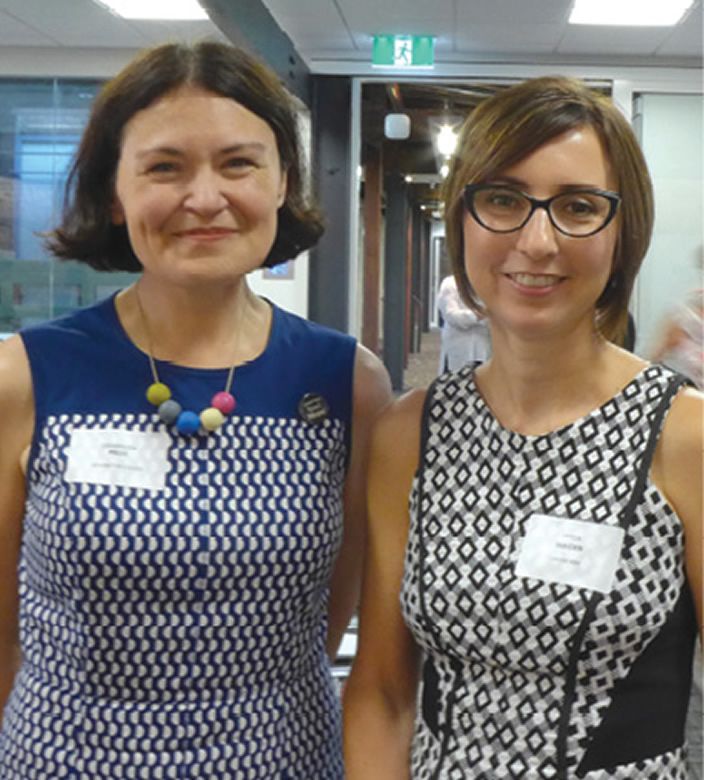
Stories of union benefits including discounts for strippers and ‘entertainment’ workers paid to drink beer with men were among those that enthralled 60 members at the IEU Women’s Committee International Women’s Day event on 4 March.
Unions NSW Assistant Secretary Emma Maiden, Newington College teacher Cassandra Pride and Kate Lee (pictured), the Executive Officer of APHEDA Union Aid Abroad spoke on a wide range of topics past and present.
Emma outlined the “chequered history” of women’s involvement with the union movement.
Women’s involvement with labour history is not always highlighted she said, but women were involved right from the beginning, with Parramatta Female Factory workers staging a dispute over withdrawn tea rations in 1827.
In 1882 the Victorian Tailoress’ Union was the first women’s union formed in Australia and possibly the world. They walked off the job due to wage reductions and their claims were met. Their actions sparked a parliamentary enquiry into factory ‘sweating’.
Emma said women tended to form their own unions and men put barriers in place to stop women’s participation.
Right up until the 1970s women were barred from apprenticeships, apart from hairdressing and dressmaking.
“Men saw women as a threat to their pay and conditions, as they were paid half as much as men,” Emma said.
The famous 1904 Harvester court judgment, decreed a man needed to support a wife and three children but a woman had no dependents and would give up work when she married, so a woman could be paid 54% less than a man.
In 1969 some women chained themselves to a Commonwealth building, demanding that women’s train fares be two thirds of men’s as they earnt two thirds less than men.
As blue collar jobs disappeared in the 1960s and 70s female union membership increased and some women took leadership roles, such as Jennie George and Sharon Burrows.
But even so, old views persisted. In the 80s the AWU boss famously said women wanted to get into shearing for the sex. One union was offering discounts to Frisky Business strippers with union membership.
Today, the gendered hierarchy is still reflected in union leadership, but the rate of 40% women in elected positions on unions is much better than the 22% on corporate boards.
“Unions get that without women in leadership their capacity to reflect their views and organise them is limited, “ Emma said.
“Research shows women are keen to take up union membership and play an active role. The union movement needs them now more than ever.”
Boys reading women
Newington College teacher Cassandra Pride said a study of children’s picture books had found male characters were significantly overrepresented compared to female. Even when the book’s character is an animal, it still tends to be male. For instance, 2011 research found three times the number of male characters to female appearing in Little Golden Books.
Cassandra said girls learn very early on they are “not present and need to inhabit male characters to be involved in books”.
And yet statistics indicate boys are lagging behind girls in literacy. Why?
A number of theories have been put forward, such as the feminisation of the education sector, testosterone making it hard for boys to be still and no male role models reading.
Cassandra has her own theory. In order to counteract this lag, education departments have come up with programs where books aimed at boys ie action hero and adventure books, are promoted in schools.
Meanwhile girls have to continue to make due with mainly male perspective books.
“We’re not allowing boys the opportunity to experience the female protagonist and fantastic female writers.
“We’re not offering boys the chance to embrace the other and stretch their imaginations.”
Cassandra posits that this limiting experience for boys is in fact causing them to fail in literacy, as from an early age they get no practice in empathising with a character of a different gender.
But her take home message is that the difference between boys and girls in literacy is much less compared to the differences between low and high socio economic groups, regardless of gender.
APHEDA Union Aid Abroad
Spokeswoman for APHEDA Kate Lee outlined the organisation’s projects with women spanning 16 countries.
For instance in Cambodia ‘entertainment’ workers are paid to drink beer with men and encourage them to drink more. Previously the beer companies did not list them as formal workers by name but as ‘allowances’.
“The women face unique OHS issues. They have to drink alcohol. They are at risk from alcohol fuelled violence and sexual assault,” Kate said.
Recent union action has lead to the women being formally listed as employees by name with the beer companies, paid a minimum wage and able to get some OHS protection.
APHEDA’s current ‘priority campaign’ is to ban asbestos use in south east Asia.
It is mainly women factory workers that are exposed to asbestos. They produce products like fire retardant fabric.
APHEDA is trying to get asbestos banned across Asia, but Kate said wealthy ‘asbestos interests’ are fighting back.
Illegal asbestos products like brake pads and last year, children’s crayons, are being imported to Australia as a result of the trade.
The IWD event group showed their support by holding up signs saying “Asbestos, not here, not anywhere”.
Union Aid Abroad needs more support and funds to fight asbestos in Asia: http://apheda.org.au/ending-asbestos-in-south-east-asia/







































































































































